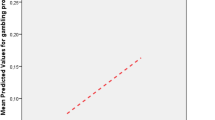Abstract
Included in both the 1996 and 1998 Survey of Gambling Behavior in New Mexico was a scale of individual problem gambling. To assess problems related to gambling behavior, questions were developed using the DSM-IV criteria for pathological gambling. The purpose of this paper is to describe problem gamblers in New Mexico. Descriptive data indicate that 12% (n = 321) of the respondents (N = 2,674) reported problem gambling behavior. Further analysis reveal that 51% of those reporting problem gambling behavior were male, and 48% of respondents were married. Forty-eight percent of problem gambler respondents identified themselves as Hispanic ethnicity and 37% non-Hispanic whites. The mean age of problem gamblers was 37.4 years, and the mean annual income was $45,638. Data were separated by survey year to analyze any changes in reported problem gambling. Overall, 12,008 people per 100,000 population reported a mild to severe gambling problem in the period 1996–1998. Statistical significance was revealed in some gambling activities between low/moderate and serious problem gamblers. Recommendations include replicating this survey in New Mexico to determine additional patterns of problem gambling.

Similar content being viewed by others
References
Abbott, M. W., Williams, M. W., & Volberg, R. A. (2004). A prospective study of problem and regular nonproblem gamblers living in the community. Substance Use & Misuse, 39, 855–884.
American Psychiatric Association (1980). Diagnostic and statistical manual of mental disorders (3rd. ed.) . Washington, DC: American Psychiatric Association.
American Psychiatric Association (1994). Diagnostic and statistical manual of mental disorders (4th ed.) . Washington, DC: American Psychiatric Association.
Brown, S. L., Rodda, S., & Phillips, J. G. (2004). Differences between problem and nonproblem gamblers in subjective arousal and affective valence amongst electronic gaming machine players. Addictive Behaviors, 29, 1863–1867.
Clotfelter, C. T., & Cook, P. J. (1989). Selling hope: State lotteries in America. Cambridge, MA: Harvard University Press.
Cullerton, R. P. (1989). The prevalence rates of pathological gambling: A look at methods. Journal of Gambling Behavior, 5, 22–41.
Dickerson, M. G. (1993). A preliminary exploration of a two-stage methodology in the assessment of the extent and degree of gambling-related problems in the Australian population. In W. R. Eadington, & J. A. Cornelius (Eds.), Gambling behavior and problem gambling (pp. 347–363). Reno, NV: Institute for the Study of Gambling and Commercial Gaming.
Dowling, N., Smith, D., & Thomas, T. (2005). Electronic gaming machines: Are they the ‘crack-cocaine’ of gambling? Addiction, 100, 33–45.
Jones, J. (2006). Devastating impact: Quick state study reveals as many as 108,000 New Mexicans may be problem gamblers. The Albuquerque Journal, Jan. 12, A1–4.
Kallick, M., Suits, D., Dielman, T., & Hybels, J. (1979). A survey of American gambling attitudes and behavior. Ann Arbor, MI: Institute for Social Research, University of Michigan.
Lesieur, H. R., & Blume, S. B. (1987). The South Oaks Gambling Screen (SOGS): A new instrument for the identification of pathological gamblers. American Journal of Psychiatry, 144, 1184–1188.
National Opinion Research Center (1999). Gambling impact and behavior study. Chicago, IL: National Opinion Research Center.
Orford, J., Spronston, K., Erens, B., White, C., & Mitchell, L. (2003). Gambling and problem gambling in Britain. London: Brunner-Routledge.
Volberg, R. A. (1996). Gambling and problem gambling in New York: A 10-year replication survey, 1986–1996. Report to the New York Council on Problem Gambling.
Volberg, R. A. (2002). Gambling and problem gambling in Nevada. Report to the Nevada Dept. of Human Resources. Carson City, NV: Dept. of Human Resources.
Volberg, R. A. (2004). Fifteen years of problem gambling prevalence research: What do we know? Where do we go? eGambling: The Electronic Journal of Gambling Issues, February 2004.
Walker, M. B. (1992). The psychology of gambling. Oxford: Pergamon Press.
Walker, M. B., & Dickerson, M. G. (1996). The prevalence of problem and pathological gambling: A critical analysis. Journal of Gambling Studies, 12, 233–249.
Wallisch, L. S. (1993). Gambling in Texas: 1992 Texas survey of adult gambling behavior. Austin, TX: Texas Commission on Alcohol and Drug Abuse.
Welte, J. W., Barnes, G. M., Wieczorek, W. F., Tidwell, M., & Parker, J. (2001). Alcohol and gambling pathology among US adults: Prevalence, demographic patterns and comorbidity. Journal of Studies on Alcohol, 62, 706–712.
Welte, J. W., Barnes, G. M., Wieczorek, W. F., Tidwell, M., & Parker, J. (2002). Gambling participation in the US—Results from a national survey. Journal of Gambling Studies, 18, 313–337.
Wiebe, J., Single, E., & Falkowski-Ham, A. (2001). Measuring gambling and problem gambling in Ontario. Toronto: Canadian Centre on Substance Abuse and Responsible Gambling Council (Ontario).
Wulfert, E., Hartley, J., Lee, M., Wang, N., Franco, C., & Sodano, R. (2005). Gambling screens: Does shortening the time frame affect their psychometric properties? Journal of Gambling Studies, 21, 521–535.
Author information
Authors and Affiliations
Corresponding author
Rights and permissions
About this article
Cite this article
Starling, R., Blankenship, J., May, P. et al. Problem Gambling in New Mexico: 1996 and 1998. Int J Ment Health Addiction 7, 138–148 (2009). https://doi.org/10.1007/s11469-008-9163-3
Received:
Accepted:
Published:
Issue Date:
DOI: https://doi.org/10.1007/s11469-008-9163-3




